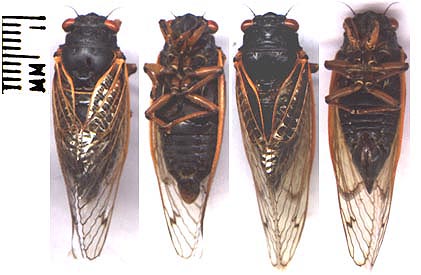Morris’ 13-year cicada

Usually smaller than M. tredecim. No orange coloration in front of the wing insertion behind the eye. Abdomen entirely black except in some locations where individuals may have weak ventral yellow-orange marks; if present, these tend to be faded and rarely form complete stripes. Sometimes such individuals may be difficult to distinguish from M. tredecula if the calling song is not available. Some M. tredecassini from the western part of their range have been reported to have orange abdominal markings, similar to M. cassini.
You can rotate the 3-D models of M. tredecassini below to see them from all angles.
General information about the signals of this species is included here.
Calling song phrases consist of a series of ticks followed by a shrill buzz. Males of Magicicada tredecassini and its close 17-year relative M. cassini sometimes synchronize their calls and flights all at once, a display that has been likened to a “giant game of musical chairs”.
Magicicada tredecassini songs:
Magicicada tredecassini songs are extremely similar to those of M. cassini.
Courtship I/ Calling song
Approximate range
In the map below, cicada symbols are verified records in our database as of 10 March 2025. This map may not be reproduced without written permission.